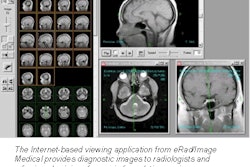SG&A Consulting Inc.
The PACS system administrator (PSA) is a position whose time has come. A hospital's PSA is a voice to be listened carefully to by the information systems, radiology, and cardiology departments.
It hasn't always been this way. In the past, an institution's PSA often got the job by taking on additional responsibilities from a RIS manager post, or was an imaging device technologist (usually nuclear medicine, ultrasound, or CT/MR) with a computer background of some sort. Many times the "some sort" was stretched, making it difficult to select the person that would learn the many intricacies of maintaining the PACS or miniPACS.
Sometimes the need for a PSA wasn't even realized until after the PACS vendor selection process had been well under way or even completed. Then the scramble began.
All too often the system administrator learned the position on the fly, without a clue to what the DICOM standard was -- or how many of a facility's imaging devices even functioned. Complicating the educational deficit were vendor shortages of application specialists, as there just weren't enough experienced people in the field yet. The schools that did exist for the institution’s selected personnel were vendor-focused, providing overviews on how the vendor’s own equipment functioned, along with quality assurance and a little DICOM/HL7 familiarization.
A new role
Today it has become apparent that the PSA must play an active role as the liaison for either the IS, radiology, or cardiology departments. But with which department is the PSA best affiliated? While we suggest that this is an institution-specific answer, the industry trend is for the PSA to liaison to the information systems department.
The PSA must be active in the role of PACS network manager, being knowledgeable of the many methods of image file acquisition, management, and display. The need to archive and make imaging files available on demand to many different groups -- whether it be the medical imaging department, the ED, the ICU, or referring physicians -- is also the responsibility of the PSA.
The PSA must determine whether to use the internal LAN or the Web-based environment, as well as what information is gathered from the RIS or the order entry module. Bringing together image files and reports for the in-house staff, or making them available to referring physicians, are other areas of expertise required of the PSA.
Responsibilities are growing for the PSA. This person will be called upon to fix files that were generated erroneously or without the proper input. These problems might stem from inadequate input from the RIS, the order entry or ADT modules, or even the PACS itself.
When a referring physician or someone in-house is looking for an image file with a report but only gets the report, they turn to the PSA by way of the director of radiology or the chief information officer (CIO). With voice recognition increasing in acceptance and popularity, additional problems are sure to arise.
Equipment procurement
Because of the PSA’s responsibilities to the IS department and the position's full-time participation in the ongoing performance of both the radiology and cardiology imaging networks, they will also become involved in the procurement of new equipment. This new opportunity will impact the vendor selection and decision-making process.
Never before has the selection of equipment depended on the network viability of the imaging device. The PSA needs to determine whether the device conforms to the institution's adherence to industry standards, and if the functionality required by the facility's departments and network is available on the equipment. These and other issues, such as whether or not the equipment meets the site's own established minimum purchasing prerequisites, must be considered when purchasing equipment.
The PSA will be asked by the various department directors to provide input in defining the institution’s purchasing requirements. Since the PSA will know best the "flow" of the radiology or cardiology department, this guidance will be critical to the performance and functional requirements for any diagnostic imaging device.
All too often today, vendors are claiming DICOM 3.0 compliance in their sales pitches and written proposals. Yet when a PACS is actually installed, some of the most popular devices still don't accommodate DICOM modality worklist functionality. The PSA should be aware of similar gaps between marketing and true performance.
The PSA will also be responsible for integrating imaging devices to the PACS network, including integration preparation and determination of the costs and necessary equipment.
Strategic planning
Given the PSA’s active participation in the overall performance of the PACS network, his or her input will be critical to the development and execution of the infrastructure and archiving strategy of the institution. This ongoing planning process requires careful adherence; the sums of money involved can be very large and sometimes difficult to justify.
The PSA can often provide very detailed information to the network services group of the IS department, thanks to their intimate knowledge of how the department functions. This input can be invaluable in determining the bandwidth necessary for the infrastructure. At this stage, the planning for process changes that occur with PACS begins, requiring careful consideration and the solicitation of input from the department administrators.
The infrastructure, as well as archiving strategy, must be determined. With the rapidly decreasing cost of storage, the need for prefetching software and all of its accompanying complexities has dramatically been reduced. It's more convenient today to maintain a large online storage environment of approximately six months to a year using very fast access RAID coupled with cheaper off-line storage media, such as a tape library.
Imaging network performance
Network performance will always be critical in the imaging environment. It will also be the primary responsibility of the PSA to have the answers when it is not performing to the demands of the institution. Having the answers is just not going to be good enough, however; the PSA must also have the wherewithal to execute a solution. This will either entail having the ability to do it alone or, more than likely, knowing who to contact to get it done effectively within a timely manner.
The future will continue to see the growing use of the diagnostic imaging network. Today we are only beginning to understand its vast opportunities.
As new diagnostic imaging and communications technologies emerge, the role of the PSA will continue to mature. Ultimately, the PSA will be responsible for determining how these two environments will work together and make it happen within their own institution.
By Stuart GardnerAuntMinnie.com contributing editor
September 17, 2001
Stuart Gardner is president of SG&A Consulting, Inc., a PACS consulting firm.
Copyright © 2001 AuntMinnie.com


















